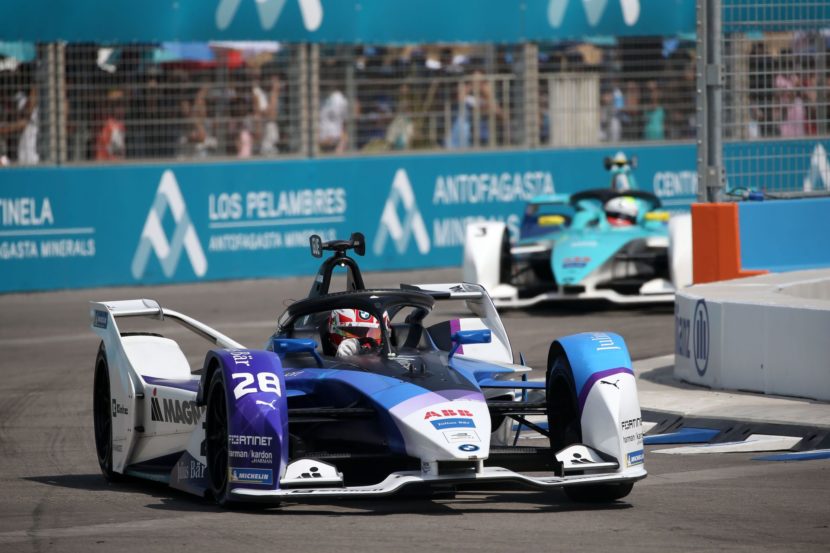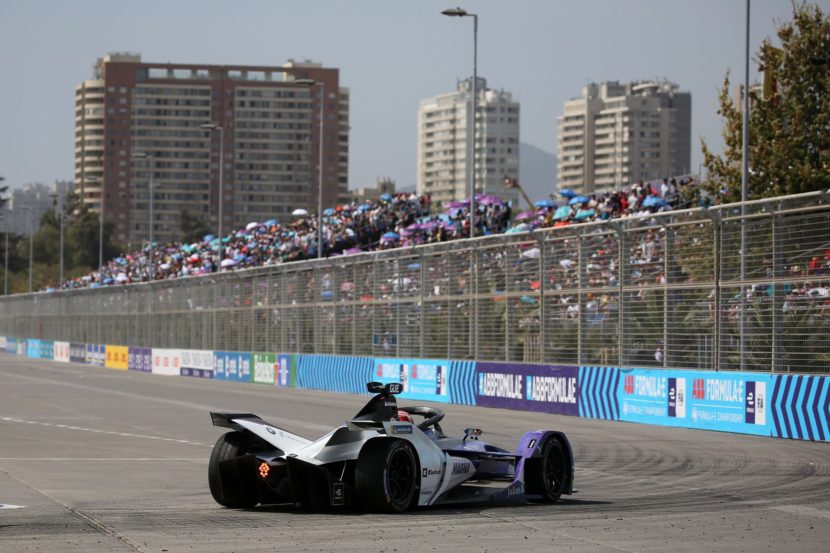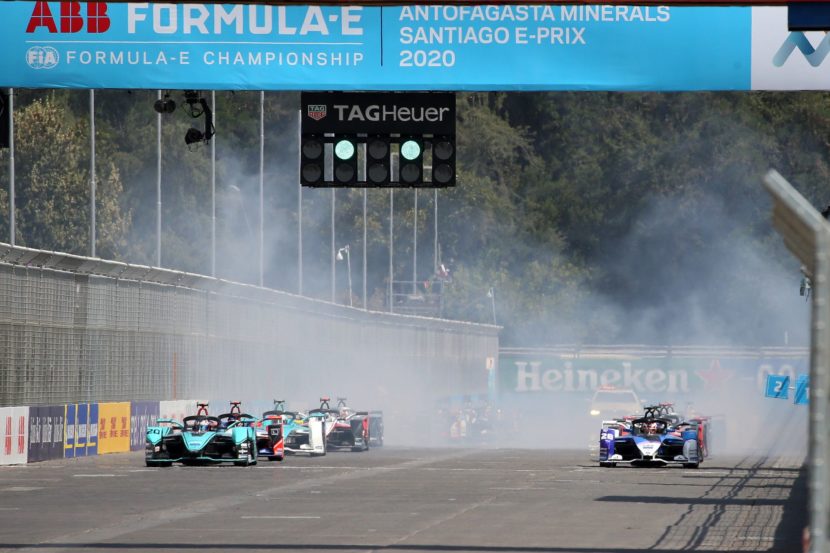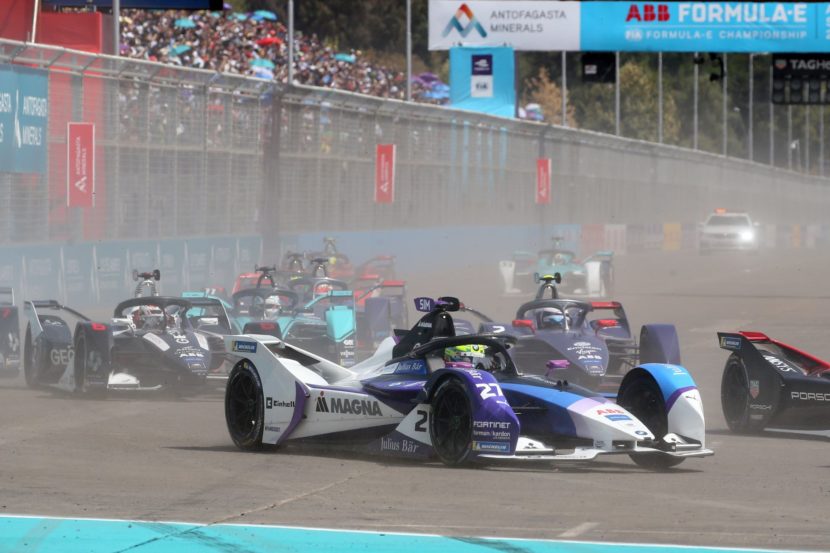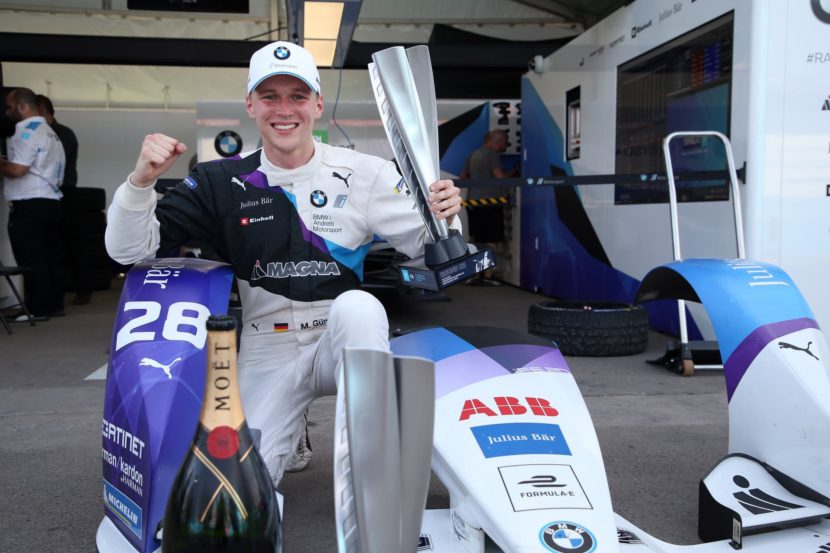Young German driver Maximilian Guenther and the BMW i Andretti Motorsport team emerged victorious at Round 3 of the 2019-2020 Formula E World Championship at Santiago, Chile with a scintillating performance that saw Guenther make an overtaking move for the lead not once, but twice, to make it two straight victories for BMW Andretti. Guenther also became the youngest Formula E race winner in the history of the sport.
Going into Round 3, expectations were heightened for the BMW i Andretti Motorsport team. The team was coming off a dominating victory in Round 2 at Ad Diriyah in Saudi Arabia, courtesy of British driver Alexander Sims, who started from pole position and was never challenged all the way up until he took the checkered flag. Compounding the high expectations was the fact that Sims and BMW had taken two pole positions on the trot in the first two rounds of the championship. In some ways, qualifying results can be considered the most accurate test for the raw pace of a Formula E car, and by that metric, the BMW Andretti team had one of the strongest driver and powertrain packages in the field.
But Formula E is a very demanding sport and the races can be long and grueling, leaving a lot of room for mistakes to happen. Often, it may not be the strongest driver or the fastest car that wins the race, but rather the team that best manages the changing conditions and situations of the race. That may have been true today.
Qualifying
Coming into the weekend, there were two main considerations for the teams to ponder. Firstly, the track had been slightly reconfigured and completely resurfaced. Gone was the bothersome chicane that split up the back straight, which meant that a fantastic overtaking zone going into Turn 9 was opened up. The final three corners of the track had been rearranged as well, resulting in a double-hairpin sequence for Turns 10 and 11.
The resurfacing effects were most evident at Turn 9, where the drivers would experience a change in track pavement midway into the turn. Speaking to journalists prior to the race, Sims mentioned that the track changes looked good and that the first two turns looked like fun. He also touched on the difficult situation posed by the transition from Turn 8 into Turn 9. Other drivers echoed his sentiments and added that the track in Santiago is very different compared to the Ad Diriyah track where the first two rounds of the championship had taken place.
Secondly, there was the element of weather. While the northern hemisphere is experiencing winter presently, it was a scorching summer afternoon in Santiago, Chile. The practice sessions would take place in the cool morning, while the qualifying session and race would take place under the full power of the summer sun.
This meant that it would be difficult for the teams to configure the right settings for qualifying and the race, given the disparity between practice conditions and qualifying conditions. In addition, the high temperatures meant that teams would have to be prudent in managing their battery temperatures — this would end up playing a major role in several crucial decisions made by the teams during the race.
There was an additional element for the BMW Andretti team to consider as well, and that was the fact that Alexander Sims, as the championship leader entering the race, would be forced to participate in Group 1 of qualifying. In a nutshell, this system of sending out four groups of six cars at a time not only lessens the amount of traffic on the track at any given time (a problem that Formula 1 struggles with) but also gives a better chance of qualifying well to drivers placed lower in the championship standings.
This is an effect of track evolution, whereby track conditions improve as more and more cars drive over the track. As the first group to head out, Group 1 would be the most disadvantaged, with the drivers forced to set their times on a “green” track, meaning that the track has not been sufficiently rubbered in. The consequences of the group qualifying system were felt in full force in Santiago — Sims set the third-fastest time in his group but ended up qualifying a lowly 15th overall in a field of 24 (12 teams, 2 cars each).
In addition, the struggling NIO 333 team was able to get Oliver Turvey into Super Pole largely as a result of their running in Group 4, the last of the groups to get out on track.
It was a different story for Guenther. Going out in Group 3, he set an excellent time to power his BMW Andretti iFE.20 to the second-fastest overall time during the group stages! That qualified him for Super Pole, a shootout for pole position involving the six fastest drivers from the qualifying group stages.
Going out as the penultimate runner because he had set the second-fastest time during the group stages, Guenther put forth another splendid lap and would qualify for 2nd on the grid for the race later in the afternoon. There was an initial penalty scare for the team, as camera footage showed Guenther exiting the pit lane while the pit lane exit light was red.
However, it was later revealed that he had exited the pit lane while the light was green, and that the red light shown was a different light. Pole position went to Mitch Evans of the Jaguar Racing Team, who had set a blistering lap that only Guenther was able to get within 8 tenths of a second of. The BMW Andretti drivers would line up 2nd and 15th for the start of the Santiago ePrix.
Race
Lining up 2nd on the grid, Max Guenther had the disadvantage of starting on the dirtier, dustier side of the grid, and also being on the outside line for Turn 2. This was a disadvantage that would unfortunately materialize for several cars. All 24 cars successfully pulled forward into their grid slots (as is the customary Formula E procedure that is used in lieu of a formation lap on most tracks), and the five lights came on to signify the start of the 45 minute + 1 lap race.
When the lights went off, it was a good start from Guenther, but the lack of grip he experienced on the dirty side of the grid meant that Mahindra’s Pascal Wehrlein, starting from 3rd on the grid, pulled alongside Guenther heading into Turn 2. Wehrlein would hold the inside line, and Guenther wisely chose not to press issues further, conceding 2nd place to his fellow German.
As evidence of the negative effects presented by starting on the dirty side of the grid, Felipe Massa and Sebastien Buemi, starting from 4th and 6th directly behind Guenther, experienced even worse starts than Guenther did and lost multiple positions at the start. Guenther raced hard behind polesitter Mitch Evans and Wehrlein in second, but was unable to find a way past and would have to settle for running in third for the time being.
Alex Sims, meanwhile, was right in the thick of the midfield, starting from 15th. He would get in a great tussle with Porsche driver Andre Lotterer, who had started from 14th on the grid. After hounding the Porsche driver for several corners, Sims launched an attack going around the outside of Turn 8, and making the overtake stick going into Turn 9.
His fortunes seemed to take another good swing, as a traffic jam of sorts unfolded in front of him at the hairpin of Turn 10, allowing him to dive up the inside of several cars to emerge from all the chaos in 11th. However, during the course of his close combat with multiple other cars during the first lap of the race, he would pick up some slight damage to the wheel cover of his front left tire.
As Sims streaked down the start-finish straight, there was a small but noticeable stream of smoke puffing out from that area of his car as a consequence of the damage, suggesting that his tire was rubbing against the wheel cover.
As a result, Sims was a touch slow on the second lap of the race, and DS Techeetah’s Antonio Felix Da Costa (a former BMW Andretti driver) would overtake him rather easily going into the Turn 10 hairpin on the second lap. That meant Lotterer was once again right behind Sims. In an overzealous attempt to gain ground on Sims, Lotterer would bump his car into Sims’s rear as the two cars went around Turn 2 once again.
But Sims defended stoutly, not allowing Lotterer to take the inside line, and thus remained ahead of him in spite of the damage on his BMW! Ultimately, it was all for nought, as the increased difficulty in driving a damaged car meant that Sims would have to stop on track after making slight contact with the barriers on track in an incident that was not televised. The race director would bring out a full course yellow to allow time for the track marshals to clear Sims’s stricken car, but this would only last for mere seconds. The race was underway once again!
While Sims was very unfortunate to have retired from the race, things were not going terribly smoothly for some of his nearest championship rivals either. Nissan’s Oliver Rowland, entering the race in fourth in the championship, made an overly ambitious dive down the inside of the Turn 10 hairpin, badly damaging his car’s front wing.
This caused a concertina effect, sending Daniel Abt’s Audi car in front of him forward to tap Virgin Racing’s Sam Bird, entering the race in third in the championship, into a spin that consigned him to the tail end of the runners.
In the meantime, things were much calmer among the frontrunners of the race. Evans drew inspiration from Sims’s dominating Ad Diriyah drive in building up a cushion to 2nd place and then taking Attack Mode early, staying in the lead. It must also be mentioned that the delta required to hold position when using Attack Mode in Santiago was smaller than it was in Ad Diriyah, due to the activation zone not being as far off line as it was in Ad Diriyah. Soon afterwards, more and more drivers made the move to arm themselves with Attack Mode. At one point, all cars running from 4th to 11th were armed with Attack Mode.
That left Guenther in a rather tough spot in 3rd place, as eight cars armed with Attack Mode were gaining on him. His taking Attack Mode then had a twofold purpose: to defend from the cars behind him (and to make sure that he did not lose too many positions whilst activating Attack Mode) and to try and get the jump on Wehrlein ahead of him. Guenther would drop to 4th behind Venturi’s Edoardo Mortara, but would immediately gain the place back on the very next lap with a bold overtaking move, going down the inside at Turn 1.
However, even his abbreviated battle with Mortara would cost him, leaving Wehrlein with enough of a time cushion to take Attack Mode and remain in front of Guenther. Thus the frontrunners would continue as they were before — Evans in first, Wehrlein in second, Guenther in third.
Then came a bit of a plot twist: with well over half the race still left to run, Evans took his Jaguar through the Attack Mode activation zone for the second time, remaining in the lead! It was an intriguing gamble, once again most likely with a dual purpose: the first being to eliminate the risk of taking Attack Mode later in the race and losing positions.
The second purpose was more interesting: the Jaguar team believed that Attack Mode would not have as great of an effect when used later in the race, due to its negative effect on the battery temperature as the race went on and the battery got hotter. Later on in the race, it would turn out that the Jaguar engineers were correct.
A silly and unnecessarily scrappy skirmish then took place behind the leading trio: Mortara, in a similar fashion to Evans, took Attack Mode, and dropped behind his Venturi teammate Massa. He then made a clumsy overtaking maneuver on Massa, running his teammate wide at the Turn 10 hairpin, allowing both DS Techeetah cars of Da Costa and defending champion Jean-Eric Vergne through past Massa. This meant that Guenther now held a sizable lead over Mortara in 4th, and he made the most of that by activating Attack Mode with about 27 minutes (+ 1 lap) to go in the race.
It was a decision that immediately proved fruitful — on the very next lap, Guenther got past Wehrlein, putting his extra 35 kwH of power to good use as he blazed around the outside of the Mahindra running through Turn 8. With race leader Evans now out of Attack Mode, Guenther began to make significant inroads in decreasing his gap to the leader. Then with less than a minute of Attack Mode remaining, Guenther made his move.
He tailed Evans down the start finish straight, forcing the Jaguar driver to defend the inside line. Guenther attempted to go around the outside of Evans in Turn 1, but had to back out when he locked up and ran out of room in the long right hander of Turn 2. However, his going on the offensive had a positive effect all the way until Turn 8, because Evans was forced to drive off the racing line in his bid to keep the BMW behind him.
On the long back straight that constitutes Turn 8, Guenther executed a similar move to the one he had just pulled off on Wehrlein, speeding around the outside of Evans to take the lead into the Turn 9 left-hander! It was a brilliant move that put the young BMW driver into the lead of the race with 23 minutes (+ 1 lap) to go.
Behind the leading duo, Vergne was able to pull off an overtaking move on Mortara, moving the Frenchman up into 4th place. Wehrlein then took that opportunity to activate Attack Mode, emerging just in front of the DS Techeetah car, still holding 3rd place. Wehrlein took Attack Mode approximately 9 minutes after Guenther had done so, but the difference between their Attack Mode stints was stark: dealing with higher battery temperatures in this later stage in the race, Wehrlein was actually unable to pull ahead of Vergne at all, despite having an extra 35 kwH of power available to his Mahindra. Vergne was then soon able to make a move on the ailing Mahindra car to move into 3rd place, though there was a decent gap he would have to make up to catch up to Evans in second.
At this point, Guenther was able to relax the slightest bit running in the lead. As revealed after the race, a software glitch meant that Evans had been unaware of his power consumption rates during the early stages of the race, and thus he had used just a tad more energy than the cars around him had while protecting his lead in the first half of the race.
Being slightly lower on usable energy, even by just 1%, was a problem that derailed Sims’s bid for victory in the first race at Ad Diriyah (before he went on to take victory at the second race at Ad Diriyah), and it would affect Evans’s race here now as well. Guenther opened up a small lead over the Jaguar driver as Evans was forced to lift off the throttle earlier on straights in a bid to lessen his energy consumption. As a result, Vergne in third place as well as his teammate Da Costa, who had managed to get into fourth, began to close in on Evans.
Disaster struck for Vergne — his front left wheel cover, damaged in a small collision at Turn 10 early in the race with the Mercedes of Stoffel Vandoorne, finally lost structural integrity and began to rub against his tire. A plume of smoke billowed from the friction between the tire and the carbon fiber, slowing the DS Techeetah driver down.
Crucially, he was either unaware of his teammate Da Costa right behind or too engrossed in keeping his stricken machine out of the barriers, and inadvertently blocked Da Costa’s overtaking maneuvers on multiple occasions, costing the Portuguese driver multiple seconds. This left Da Costa fuming over the radio, and he was correct in being furious because the seconds lost here may have cost him the victory at the end of the race.
Surprisingly, Vergne repeatedly decided not to make a pit stop to fix the damage on his car, instead electing to continue his bid for a points-paying position by staying out and hoping that the damage would resolve itself. In the end, the damage he suffered was too great and he was still forced to pull into the pits, effectively ending his race.
During this time, Mortara also pitted with problems, ending his race as well. With 9 minutes (+ 1 lap) of the race remaining, Guenther had extended his advantage in the lead of the race to a healthy 2.0 seconds.
With his teammate out of the way, and sporting a touch more remaining usable energy than most cars around him, Da Costa was now given the green light to attack Evans for second place. He was able to get the job done with 6 minutes (+ 1 lap) remaining in the race, and now set out on hunting Guenther down.
The DS Techeetah car’s pace was blistering, and Da Costa closed in on Guenther, gaining as much as 1.3 seconds in a single lap! In radio messages between Guenther and his team, it was easy to recognize the heightened urgency with which Guenther spoke as the DS Techeetah car appeared larger and larger in his mirrors.
His race engineer reassured him, though, emphasizing that Da Costa’s battery might experience temperature issues with the intense speed at which he was driving. With 2 minutes (+ 1 lap) remaining, Da Costa lunged down in the inside of Guenther at the Turn 10 hairpin with an overtaking maneuver of questionable legality, coming from a car’s length back to tap Guenther’s car out of the way and force his way up the inside.
Both drivers were very lucky — Guenther was lucky to have not spun or hit the wall, and Da Costa was lucky to escape without a penalty. Surely Da Costa would have been penalized had Guenther suffered more adverse effects from the lunge. But the result was that Da Costa now held the lead of the race over Guenther.
Things were not going smoothly for the DS Techeetah team at this point though. Da Costa’s race engineer suddenly radioed him, telling him to go as slowly as he could while maintaining the lead because their battery temperatures were critical. Guenther was thus able to stay right on the tail of the former BMW driver as they rounded the circuit for the final time. The young German did a great job of remaining calm and composed even after being passed for the lead with just a few laps to go, and the team did a fantastic job of prioritizing battery temperatures over track position. They knew that they had a similar SOC (state of charge, referring to the amount of usable energy left) as Da Costa did but were doing much better in terms of managing battery temperatures.
Da Costa’s team continued to hound him, imploring him to keep the battery temperatures down. Guenther and the BMW Andretti team, on the other hand, had managed the race beautifully, even having the presence of mind to not overcook the battery in defending from the fast-approaching Da Costa a few laps prior.
Guenther thus had no battery temperature issues, and his race engineer continued to remind him of that fact. Heading into the back straight on the final lap, Guenther was as close as he had ever been to the tail of the DS Techeetah car. Midway through the straight, Da Costa was forced to lift off the throttle in an attempt to keep his battery temperature issues at bay. Guenther, however, was pedal-to-the-metal over the entire straight.
He pulled out to the right of Da Costa, sweeping around the outside of the former BMW driver with a beautiful pass ahead of Turn 9, just as he had done against Wehrlein and Evans before!
Celebrations were muted in the BMW Andretti garage because the team knew there were still two corners before the end of the race. But Da Costa was utterly helpless to launch a counterattack at this point, and quickly fell 2 seconds behind Guenther. Guenther then rounded the final Turn 11 hairpin and passed in front of the main grandstand for the final time, evoking loud cheers from the crowd.
He pulled over towards the pit wall and crossed the finish line to win the race, the first of his Formula E career! In doing so, he became the youngest race winner in the history of Formula E. Behind him, Antonio Felix Da Costa came home in second place in his DS Techeetah, and a late penalty for Mercedes’s Nyck de Vries (for a technical infringement) promoted Mitch Evans back into third place in his Jaguar and also allowed Pascal Wehrlein to finish in fourth. Nyck de Vries (Mercedes), Stoffel Vandoorne (Mercedes), Lucas di Grassi (Audi), James Calado (Jaguar), Felipe Massa (Venturi), and Sam Bird (Virgin) completed the top 10.
Speaking with reporters after the race, Guenther was ecstatic and reveled in his first Formula E race victory. He was delighted to have won a “challenging” race and labeled it a “nice fight until the end.” Da Costa was disappointed that his battery temperature issues had not been revealed to him earlier, as he felt he would have bided his time more prudently to attack Guenther later in the race had he known the precarious situation his battery had been in.
Evans was understandably dissatisfied with third place after such a strong pole position, and lamented that the team still had a lot of work to do. Evans also mentioned an interesting fact — that the team had to seesaw back and forth on their calculations during the race due to uncertainty on exactly how many laps the 45 minute race would last.
In the end, Da Costa (the leader at the time) crossed the start line mere seconds after the clock hit 0:00, meaning that that lap would represent the penultimate lap of the race. If he had started the lap before the clock hit 0:00, there would have been three laps to go until the end of the race. A crucial variable to the endless calculations of the teams’ engineers, given that the cars tend to finish with less than 1% of usable energy remaining!
What a difference a year makes for the young and talented Maximilian Guenther. A year ago, he was a rookie in Formula E, driving for the struggling Dragon team. Despite several standout performances in which he achieved strong results in a car which was universally seen as having one of the weaker powertrains, Guenther was forced to give up his seat to Felipe Nasr on several occasions.
But Guenther had shown remarkable maturity at such a young age, continuing to turn in excellent performances whenever given the chance and never speaking negatively of the team, despite being treated like a back-up driver when his talent and results proved otherwise.
In the end, his talent and composure caught the eye of the BMW Andretti team and he was signed as Da Costa’s replacement at the team. And just three races later, Guenther has justified the faith that the BMW brass showed in him with an exciting victory that came as a result of a measuredly aggressive yet remarkably composed drive.
BMW Motorsport director Jens Marquardt joined Guenther on the podium to celebrate the BMW i Andretti Motorsport team’s second straight victory. The victory sees Guenther jump up to 4th in the drivers’ championship, behind Sims in 2nd. The combined performances from the two drivers also means that BMW Andretti move to first place in the constructors’ championship!
Round 4 will take place at Autódromo Hermanos Rodríguez in Mexico City on February 15th, 2020. The Formula E cars will run through a smaller configuration of the race track compared to the configuration used for Formula 1. This race will pose a major challenge to the BMW i Andretti Motorsport team as both Sims and Guenther will take part in Group 1 of qualifying.
Last season, Antonio Felix Da Costa, driving then for BMW Andretti, was able to secure 2nd place in a thrilling finish after the two BMW Andretti cars qualified in 5th and 7th, and the team will be hoping for a similarly strong result this year.



